
This variegated Colocasia was spotted as a baby at the local garden centre, in the spring and I quickly realized that it was exactly what was needed for the top of the waterfall. It sits submerged in the small pond where the water emerges from the pump and it has flourished. Lots of water and of course that water is rich in nutrients thanks to the fish. Its roots act as a great filter removing lots of stuff, a very technical term, from the water. Its only drawback is that it wants to face south towards the sun and that sort of hides it behind a big rose bush. I’ll be sure to save its large corm after the frost has taken down its leaves and store it in my cool dark basement.
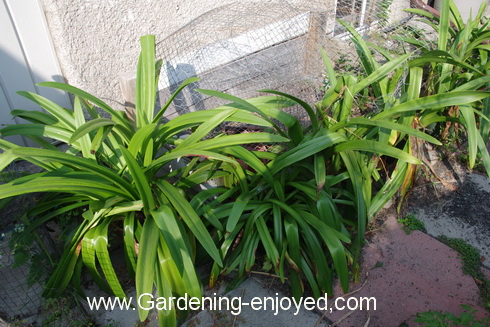
These happy Amaryllis have been sitting outside getting several hours of sun every day and frequent watering including some soluble fertilizer. The leaves are thick and green and their bulbs are fat and happy. Cold weather is coming and they really don’t like even the tiniest touch of frost. My weather report indicates that it is going to stay toasty warm for at least another week but I will be keeping a close watch. At the first sign of a cool night they will have their summer sunbathing abruptly halted and they will retire to the cool dark basement with no water provided. After a couple of months of this, the leaves will have all died down and will be removed. A few of them are pushing at the sides of their containers and when they start to find their way upstairs, one by one, starting by mid December, they will either get broken up into a couple of separate bulbs or the they will move to a bigger pot. In those
pots they will stand, up to their waist, in water for a couple of days and then make their way to the kitchen counter to be bathed in warm sunlight. There we can observe the rapid growth of their bloom stalks with those huge blooms that make all the shuffling and fussing worth the effort.
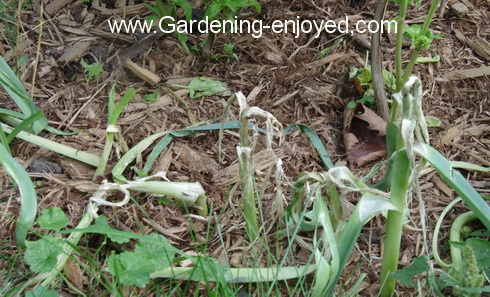
Not everthing we do is successful. Mother Nature has to occasionally remind us who is actually in control. The soggy mess in this picture is what is left of many of my Leeks. A nasty little invasive species, the Leek moth, has visited these tasty treats a while ago and laid some eggs. Those eggs become larva that tunnel into the shaft of the Leeks and then work their way down towards the soil eventually returning to the leaves to spin a cocoon for the pupa. It is possible to have up to three generations in a season. I’ve found a few in my Garlic in previous years but they have multiplied to devastate the Leeks this year. Next year’s Leeks will get much closer inspection and we may resort to row covers to protect them.
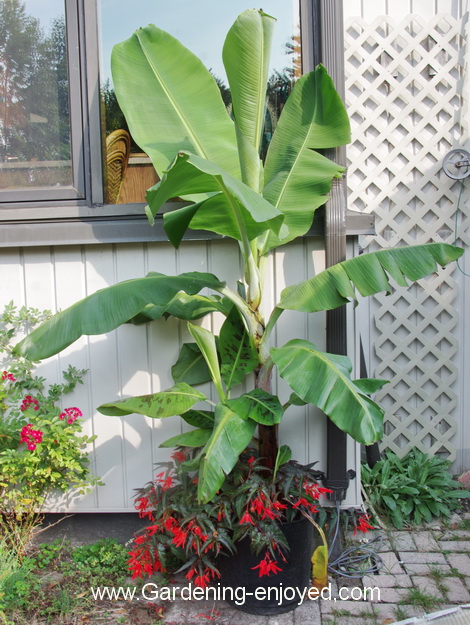
We don’t anticipate picking any fruit but this Banana plant has certainly earned its keep this summer. I found it in a small pot at my local Canadian Tire store in the spring and quickly snatched one up. Apparently I didn’t need to hurry as there was still a cart full of them available in mid August. Others apparently didn’t see the opportunity that I saw. It found its way into a large container, naturally with a few Begonias around the edge, and received my usual regular watering, most times with some soluble fertilizer. Of course I became the victim of my own success as it has now needed water on a daily basis for the past few weeks. There is no thought of trying to overwinter it although I could try with one of its small offsets. At 2 m+ it just lights up that corner of the house and makes that pathway wonderfully interesting to push through.
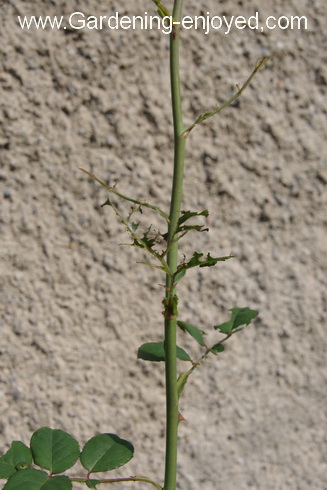 I was admiring the amazing growth that many of the Roses have exhibited these past few weeks. Some of them have put out new shoots over a metre in length and then added some blooms to the end of those shoots. While admiring them I noticed this one with most of the foliage eaten, on the top 40 - 50 cm. I climbed in between all of this wonderful growth to see who I could see and on close inspection I found a couple of these little curled up green creatures trying to hide from me. These are commonly called Rose Slugs, Allantus cinctus but they are actually the larva of one of the two Rose Sawfly that wander by occasionally to lay some eggs. These ones have two generations a season which is why I am finding them again now. They can be a bit difficult to find as they curl up in a ball and usually hide in the leaf axils or other cosy corners. They can do significant damage but are easily controlled by hand picking, if you can spot them, as they are usually small in
number. Look carefully at the bottom leaf.
I was admiring the amazing growth that many of the Roses have exhibited these past few weeks. Some of them have put out new shoots over a metre in length and then added some blooms to the end of those shoots. While admiring them I noticed this one with most of the foliage eaten, on the top 40 - 50 cm. I climbed in between all of this wonderful growth to see who I could see and on close inspection I found a couple of these little curled up green creatures trying to hide from me. These are commonly called Rose Slugs, Allantus cinctus but they are actually the larva of one of the two Rose Sawfly that wander by occasionally to lay some eggs. These ones have two generations a season which is why I am finding them again now. They can be a bit difficult to find as they curl up in a ball and usually hide in the leaf axils or other cosy corners. They can do significant damage but are easily controlled by hand picking, if you can spot them, as they are usually small in
number. Look carefully at the bottom leaf.
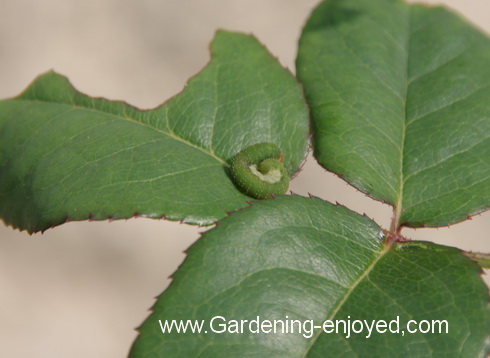
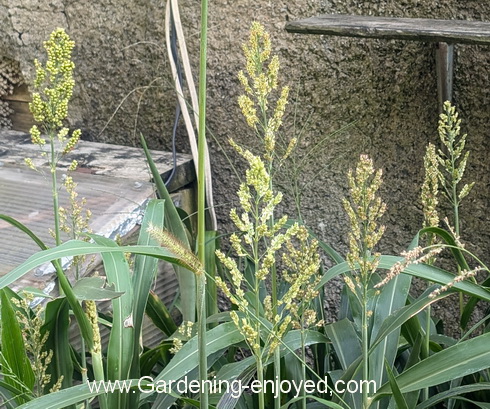
This lovely crop of feathery seed heads is a volunteer crop growing in a rocky bed underneath the location of the bird feeder. It is Sorghum which is the fifth most popular grain crop around the world. It is, obviously, widely used in the wild bird food that we buy to fill our bird feeders. It can happily grow in hot dry conditions which explains its success in the river stone bed under our bird feeder. It looks quite attractive and it’s about the only thing that I’ve been able to grow in this location and I didn’t even plant it. I’ll try just leaving the plants standing there to see if the birds will enjoy it straight from the seed heads.
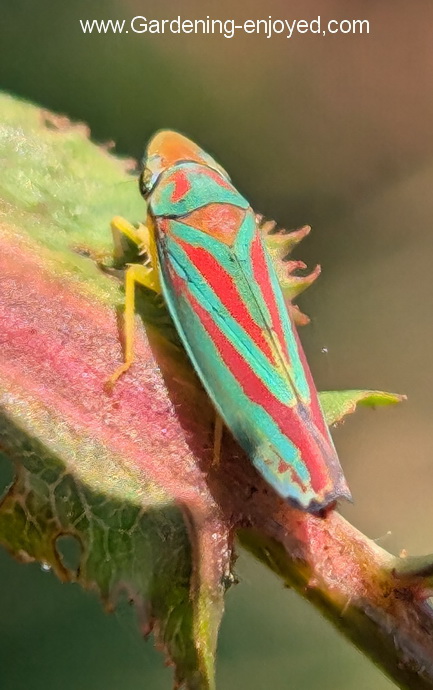
He’s quite small and very attractive but he does like to suck his dinner out of the leaves of my plants which tends to turn them brown and rather dead looking. The Red Banded Leafhopper is very obvious when you do manage to detect him but the bright colouration is also rather good camouflage. I found him enjoying one of my Rose bushes and after taking his portrait I suggested that he was not exactly welcome.
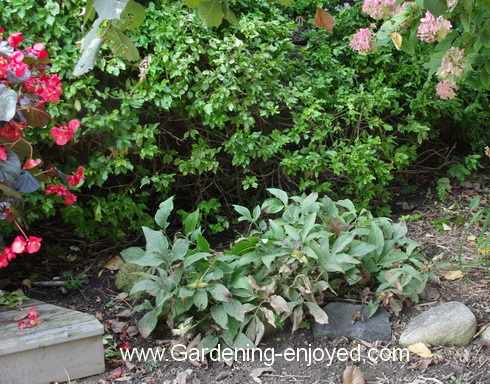 Here’s a chore that I’m exactly looking forward to. This delightful Peony, Starlight, is a light cream coloured single that has always been a bright spot in this garden. I looked it up, it has been there for 18 years which makes this project even less appealing. The Hydrangea beside it and the Camperdown Elm in front of it have grown so much that it is now almost completely shaded and thus blooms very poorly. It must be moved and it will have a massive root making this a several hour job. A little backhoe could be handy. Late September, early October, is the correct time of year to undertake this job, so there is no room for more procrastination. The next job, of course, is where to move it to? When I get it to that spot I have to remember the one really important rule with Peonies. Plant it with the eyes, next year’s growing points, no more than 2 - 3 cm under the surface of the soil. Planted too deeply it
will grow beautifully but never flower. Once it is dug up and had most of its soil removed it will probably take a pruning saw to separate it into good divisions with, hopefully, at least 5 eyes. It will actually grow much better if I replant a healthy division rather than trying to replant that entire root. If I manage to do it all successfully it will reward me handsomely, with those large cream coloured blooms next spring.
Here’s a chore that I’m exactly looking forward to. This delightful Peony, Starlight, is a light cream coloured single that has always been a bright spot in this garden. I looked it up, it has been there for 18 years which makes this project even less appealing. The Hydrangea beside it and the Camperdown Elm in front of it have grown so much that it is now almost completely shaded and thus blooms very poorly. It must be moved and it will have a massive root making this a several hour job. A little backhoe could be handy. Late September, early October, is the correct time of year to undertake this job, so there is no room for more procrastination. The next job, of course, is where to move it to? When I get it to that spot I have to remember the one really important rule with Peonies. Plant it with the eyes, next year’s growing points, no more than 2 - 3 cm under the surface of the soil. Planted too deeply it
will grow beautifully but never flower. Once it is dug up and had most of its soil removed it will probably take a pruning saw to separate it into good divisions with, hopefully, at least 5 eyes. It will actually grow much better if I replant a healthy division rather than trying to replant that entire root. If I manage to do it all successfully it will reward me handsomely, with those large cream coloured blooms next spring.
The roads are pleasant to drive on this time of year, as I am travelling around sharing my various presentations with hort. societies, garden clubs and corporate presentations for lunch and learns. I would love to come and visit your organization. Check out my web page at Gardening-enjoyed.com for more details on topics and availability.
If you have any gardening questions just “reply” to this emailed newsletter and I will attempt to answer them and then share
them here if they are of wide interest.
Nadia Asks?Hello Ken.....was hoping you might have some comments on overwintering dahlias, come this fall.
Ken Answers! Dahlias are fairly simple to overwinter. They produce rather large clusters of tubers. When the frost has knocked down the tops carefully dig up those tubers and let them dry so that you can easily brush off any soil. Keep them in the dark in a cool place about 8 - 10 C and then pot them up in late March, giving them warmth and lots of light. They will look very shrivelled and dead when you go to pot them up but do not be afraid, they will grow.
Sue Asks? Got me thinking that you might be able to guide me to where I should purchase some grow lights and perhaps the corresponding stand(s).
Not big on starting seeds, but do save and grow cannas, dahlias....most any tuber is my thing....which of course need to be potted up and under some light while
it is still too cold to put them outside.
Ken Answers!I don't overwinter much under lights but rather in my solarium except for a bunch of Geraniums. That said, I am slowly replacing all of my fluorescent lights for seed starting with LEDs. There are 4' LED fixtures that put out more and better light than a standard 2 tube, 4' fluorescent. I find them at Costco for around $40 and they come complete with cords and plugs and chains to hang them with. All you need is someplace to hook that chain onto.
Huberte Asks?I need your help and expertise. It' regarding my Burning Bush. The leaves on some branches are turning brown. I remove them, then it goes to the next branch, to the next branch ... Is it dying? I hope not! Please help!!!
Ken Answers! There is a euonymus scale that can cause that effect on your Burning Bush, Euonymus alata. Spider mites have also been found on that plant but that is probably unlikely in its
outdoor location. Since it seems to spread as you remove leaves it might be insufficient water which could be the cause particularly if it is a relatively newly planted specimen.
|

 I was admiring the amazing growth that many of the Roses have exhibited these past few weeks. Some of them have put out new shoots over a metre in length and then added some blooms to the end of those shoots. While admiring them I noticed this one with most of the foliage eaten, on the top 40 - 50 cm. I climbed in between all of this wonderful growth to see who I could see and on close inspection I found a couple of these little curled up green creatures trying to hide from me. These are commonly called Rose Slugs, Allantus cinctus but they are actually the larva of one of the two Rose Sawfly that wander by occasionally to lay some eggs. These ones have two generations a season which is why I am finding them again now. They can be a bit difficult to find as they curl up in a ball and usually hide in the leaf axils or other cosy corners. They can do significant damage but are easily controlled by hand picking, if you can spot them, as they are usually small in
number. Look carefully at the bottom leaf.
I was admiring the amazing growth that many of the Roses have exhibited these past few weeks. Some of them have put out new shoots over a metre in length and then added some blooms to the end of those shoots. While admiring them I noticed this one with most of the foliage eaten, on the top 40 - 50 cm. I climbed in between all of this wonderful growth to see who I could see and on close inspection I found a couple of these little curled up green creatures trying to hide from me. These are commonly called Rose Slugs, Allantus cinctus but they are actually the larva of one of the two Rose Sawfly that wander by occasionally to lay some eggs. These ones have two generations a season which is why I am finding them again now. They can be a bit difficult to find as they curl up in a ball and usually hide in the leaf axils or other cosy corners. They can do significant damage but are easily controlled by hand picking, if you can spot them, as they are usually small in
number. Look carefully at the bottom leaf. 
 Here’s a chore that I’m exactly looking forward to. This delightful Peony, Starlight, is a light cream coloured single that has always been a bright spot in this garden. I looked it up, it has been there for 18 years which makes this project even less appealing. The Hydrangea beside it and the Camperdown Elm in front of it have grown so much that it is now almost completely shaded and thus blooms very poorly. It must be moved and it will have a massive root making this a several hour job. A little backhoe could be handy. Late September, early October, is the correct time of year to undertake this job, so there is no room for more procrastination. The next job, of course, is where to move it to? When I get it to that spot I have to remember the one really important rule with Peonies. Plant it with the eyes, next year’s growing points, no more than 2 - 3 cm under the surface of the soil. Planted too deeply it
will grow beautifully but never flower. Once it is dug up and had most of its soil removed it will probably take a pruning saw to separate it into good divisions with, hopefully, at least 5 eyes. It will actually grow much better if I replant a healthy division rather than trying to replant that entire root. If I manage to do it all successfully it will reward me handsomely, with those large cream coloured blooms next spring.
Here’s a chore that I’m exactly looking forward to. This delightful Peony, Starlight, is a light cream coloured single that has always been a bright spot in this garden. I looked it up, it has been there for 18 years which makes this project even less appealing. The Hydrangea beside it and the Camperdown Elm in front of it have grown so much that it is now almost completely shaded and thus blooms very poorly. It must be moved and it will have a massive root making this a several hour job. A little backhoe could be handy. Late September, early October, is the correct time of year to undertake this job, so there is no room for more procrastination. The next job, of course, is where to move it to? When I get it to that spot I have to remember the one really important rule with Peonies. Plant it with the eyes, next year’s growing points, no more than 2 - 3 cm under the surface of the soil. Planted too deeply it
will grow beautifully but never flower. Once it is dug up and had most of its soil removed it will probably take a pruning saw to separate it into good divisions with, hopefully, at least 5 eyes. It will actually grow much better if I replant a healthy division rather than trying to replant that entire root. If I manage to do it all successfully it will reward me handsomely, with those large cream coloured blooms next spring.




